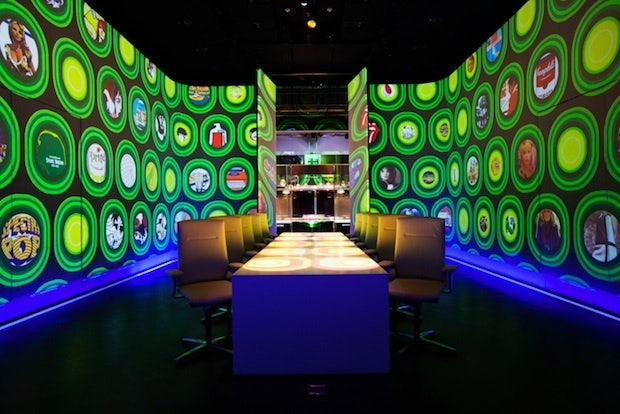
The Ultraviolet dining room. (Scott Wright/Limelight Studios)
It is no surprise that the most futuristic restaurant in the world is in Shanghai.
Ultraviolet, which chef Paul Pairet calls “the project of my life”, needs almost no introduction. As the first restaurant attempting to unite food with multi-sensory technologies to create a “fully immersive” experience, it parades some astonishing stats. The space features 30 tons of steel, 146 light bulbs, 56 Sennheiser speakers, seven projectors, and 10 screens creating a 360 degree HD view, a custom-created dry scent diffuser from a French fragrance house, 4,500 pieces of tableware from names like Raynaud, Ercuis, Zwiesel, and one of the most advanced kitchens in the industry featuring a custom-made, heavy-duty stainless steel Molteni, all for a cool $2.5 million USD. With this stunning setup, it’s no wonder the concept was under development for more than 15 years—mainly because Pairet needed an investor crazier than even himself.
He found this partner in JC Chiang, chairman of a luxury footwear company and the VOL Group, credited with outfitting the historic Bund 18 complex with such wildly successful establishments as Pairet’s Mr & Mrs Bund and hedonist dreamland Bar Rouge, which conform well to the atmosphere of Shanghai, a city constantly racing to reinvent itself. With all the pieces in place, ground was broken for the world’s most expensive restaurant per head in terms of cost to the restaurant. Ultraviolet holds one of the world's record ratios of employees per guest at 2.5 staff to every patron. Just to break even, it would have to charge 5,000 RMB per guest. Do the math and you can see why there were so few takers, and why others likely won’t catch up anytime soon.
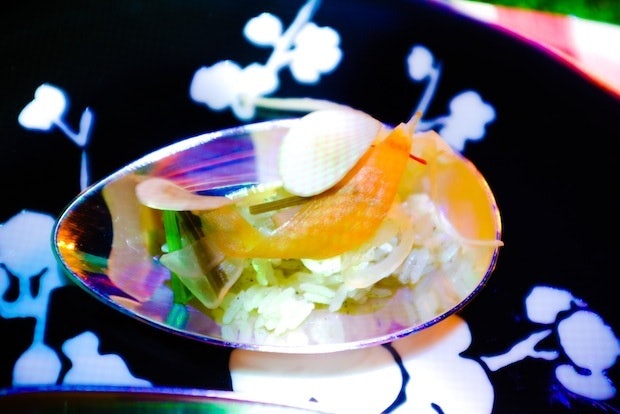
Ultraviolet spends the most money per head of any restaurant in the world. (Jenny Gao)
How does Ultraviolet make money? According to Pairet, it doesn't. To him, an experimental project like this cannot subscribe to the traditional model of revenue. Rather, it acts as a strong marketing tool, operating on a unique partnership model with like-minded companies such as Kohler, Electrolux, Miele, Sennheiser, Baccarat, Zwiesel, Molteni, and many others who benefit from Ultraviolet's innovative and unique image.
Expectations are high when stepping into the black-lit altar of Paul Pairet. If your name is on the list for one of the restaurant’s ten coveted seats, you have probably been waiting three months for this evening. This is how far in advance the restaurant is usually booked. It is likely your birthday, or a special occasion—one that you wouldn’t mind splurging on. Since its opening in 2012, Ultraviolet’s price per head has increased by 25 percent to 2,500 RMB, or $408 USD at last conversion.
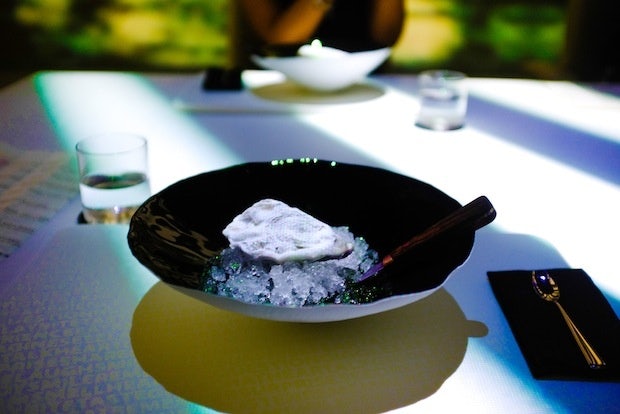
The restaurant was under development for 15 years before coming to fruition. (Jenny Gao)
For the start of your dining experience, an email directs you to Mr & Mrs Bund, Pairet’s other modernist French eatery on the Bund at 6:30 to be shuttled to “a secret location”. You sip on a glass of pear cider and size up your dinner companions for the night, a group of immaculately dressed strangers. A palpable sense of anticipation builds with every passing minute.
Already, elements are at work, influencing in your mind what Pairet calls “psycho taste”, the preconceived idea of what taste should be based on memory, imagination, experience, and culture. This is what your mind is anticipating, and consists of all of the expectations you have built about your meal up until now. What Pairet wants to probe is how this “mindset” taste impacts actual taste.
From this moment on, you surrender all control of your senses. Every moment is orchestrated in fine detail, all to drive the plot of Pairet’s greatest work yet, the operatic feast that is Ultraviolet. Down a dark alley in the depth of a parking garage, doors open, lights flash, the dramatic overture of “Also Sprach Zarathustra” fills the room, and you start to get an idea of the night ahead.
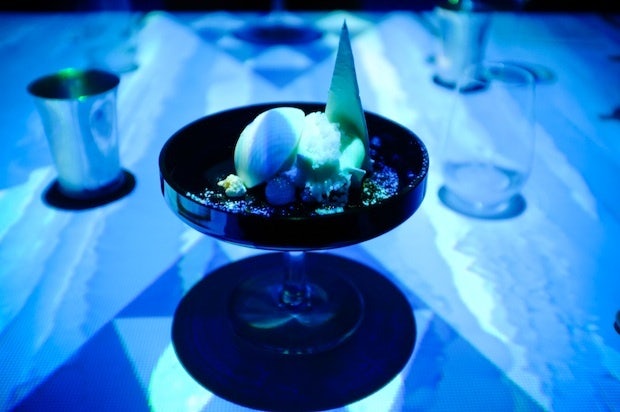
Brands including Kohler, Electrolux, Miele, Sennheiser, Baccarat, Zwiesel, Molteni, and more have teamed up with Ultraviolet. (Jenny Gao)
Paul Pairet was born in France, and lived and cooked at a young age in Hong Kong, Sydney, and Jakarta before honing his skills under Alain Ducasse in Paris, developing a new French style all his own. After a stint in Istanbul, Pairet landed in Shanghai where he changed the fine dining game at Jade on 36. Recipes honed and perfected then reappeared on his menus at Mr & Mrs Bund and Ultraviolet, where devotees can still find signatures like the Truffle Burnt Soup Bread.
These days, Pairet spends most of his time at Ultraviolet, either in the kitchen or his office on the second floor. He presides over two large Apple screens, where he shows me an elaborate spreadsheet he uses for menu development. It describes each course in painstaking detail, the inspiration, mood, down to the weight of the ingredients. From his desk, he peers down a tinted glass window at his kitchen crew, preparing for nightly service. To his left, a large LCD screen displays closed circuit video of the dining room from several angles. This looks more like the set of a sci-fi film than behind the scenes of a fine dining restaurant. But it's not all just steel and glass, the fireman's pole connecting the second floor office to the kitchen is a throwback to the childhood schoolyard, a window into his boyish, playful nature.
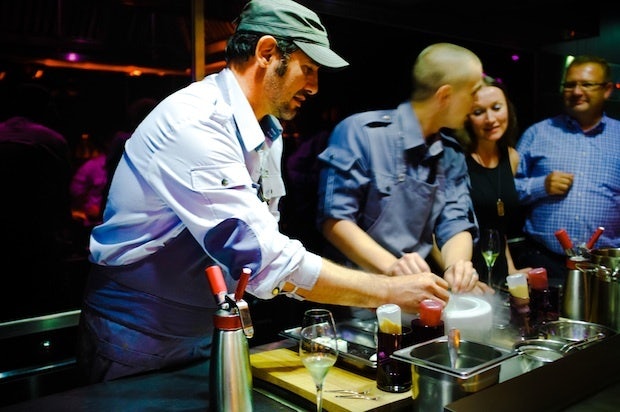
Paul Pairet at work in the kitchen. (Jenny Gao)
Meal 317 begins like every other meal before it. The eclectic group that gathered on this particular night included a rotund German industrialist, his much younger Russian girlfriend, the proprietor of a popular Italian restaurant on the Bund, and several Chinese girls in their late twenties, one of them a model who spent most of the evening taking selfies with her iPhone at the table. I'm told this is representative of the usual guests at Ultraviolet; mostly Westerners, foodie diehards, wealthy businessmen, and the occasional nouveau riche young Chinese.
We are handed our menus, rice paper sheets the size of two index fingers that fold out like a map, charting the course of our meal. The journey that followed was absorbing, at times psychedelic, full-on, often parodic, and playful. Pairet says he tries to create the best possible context for the food, meaning everything else is supporting. “Imagination is a magnifier that transforms appetite into desire…You should, here, believe a specialist: imagined taste is generally better than reality,” he said. Since the database from which we judge or imagine taste is mostly cultural, the more experienced one is, the more there is to draw from. If there is anything about Ultraviolet more exclusive than the price, this might be it. A rich taste bank is the ultimate luxury.
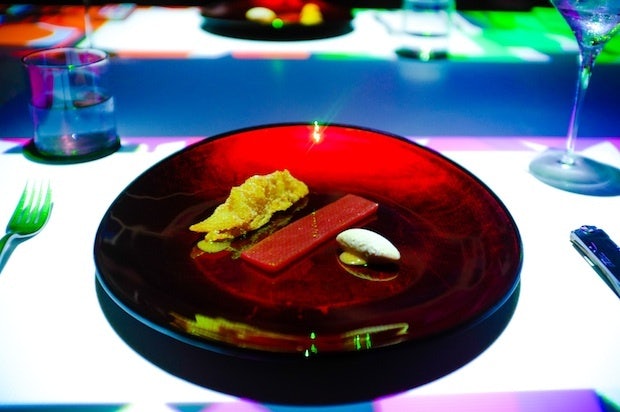
Pairet plays with the idea of “psycho taste”, the preconceived idea of what taste should be based on memory, imagination, experience, and culture. (Jenny Gao)
For an oyster course, we are transported seaside, surrounded by the sound of waves crashing and the smells of the ocean. Handed a shucking knife, we are instructed to open our own oyster. Inside is a pocket of frozen salt water encasing briny chunks of meat dotted with caviar. Each mouthful recalls another memory of the sea, while simultaneously creating new ones, of being in this moment, in this place. Some of the flavors are transcendent. The “Tea-Weed Crab Melba” found its perfect pairing with Lagavulin mixed with lapsang souchong iced tea. Cutting into the “Sashimi Steak Frites” with our custom Fontenille Pataud steak knives in the lively setting of Tsukiji fish market felt monumental, electrifying. Pairet’s signature ‘Truffle Burnt Soup Bread’ has been known to bring grown men to tears, and I could finally see why. Set in a mystical forest, surrounded by the smell of damp moss, the intense flavor of cigar smoke recalls a personal memory of Pairet’s truffle hunting in Dordogne.
Several times, I was left feeling like there couldn’t possibly be anything that could make the dish better, an affirmation of Pairet’s ethos that “a dish is ready when there is nothing left to add or take away…above all, flavors should taste divine, assertive, sending taste buds into raptures”. Whether it was imagined taste impacting actual taste remains unclear, but one thing is for certain: the memory of this meal won’t soon be forgotten.
Based in Shanghai, Jenny is a freelance writer, producer and photographer. She has been published in Conde Nast Traveler, Epicure, Time Out, CNNGo, and has appeared on BBC's documentary "Exploring China: A Culinary Journey" and "Fresh Off the Boat", an award-winning food show on Vice.com. She writes the blog JING THEORY, a website about Chinese food culture.
She was born in Chengdu, a UNESCO City of Gastronomy.